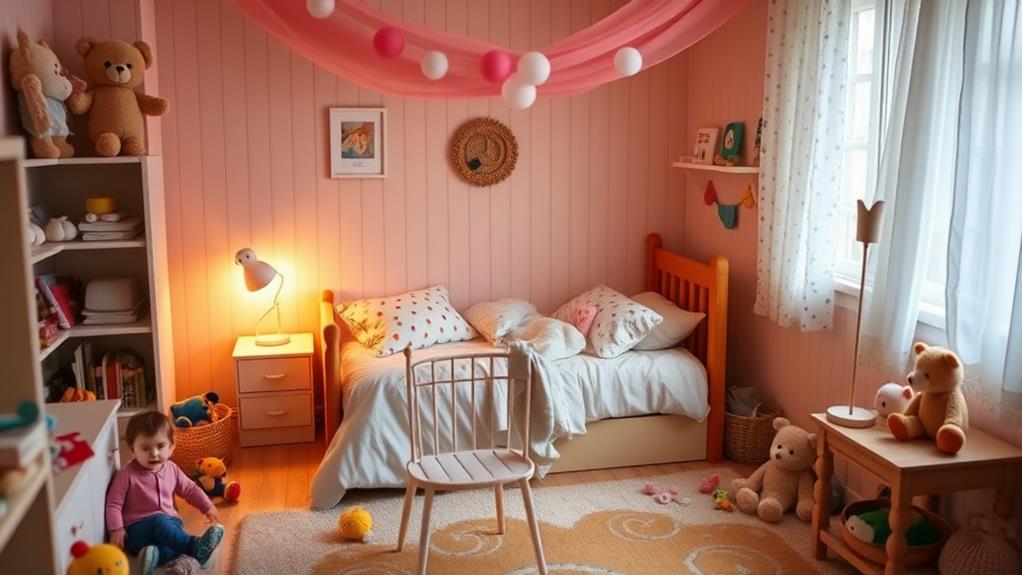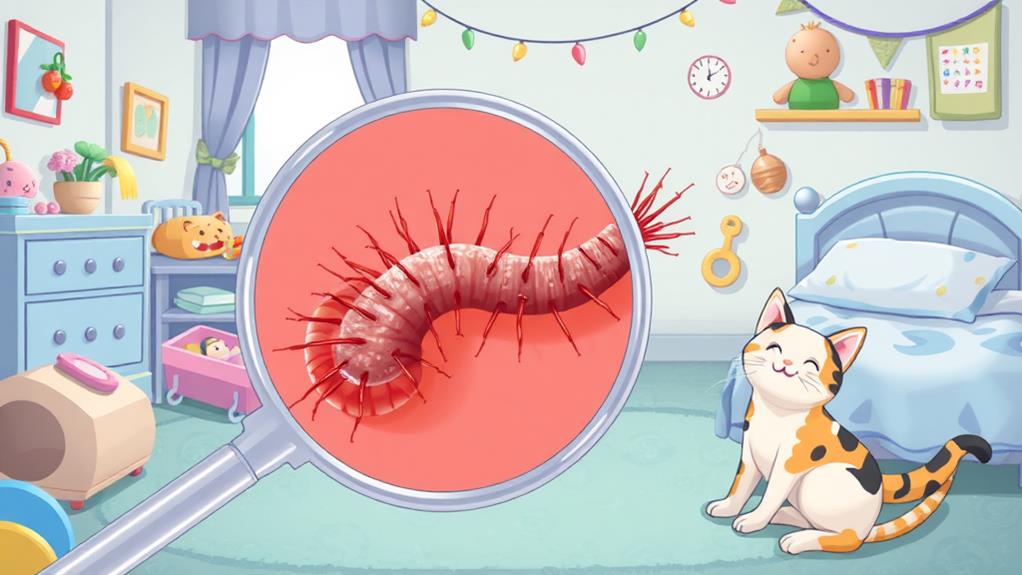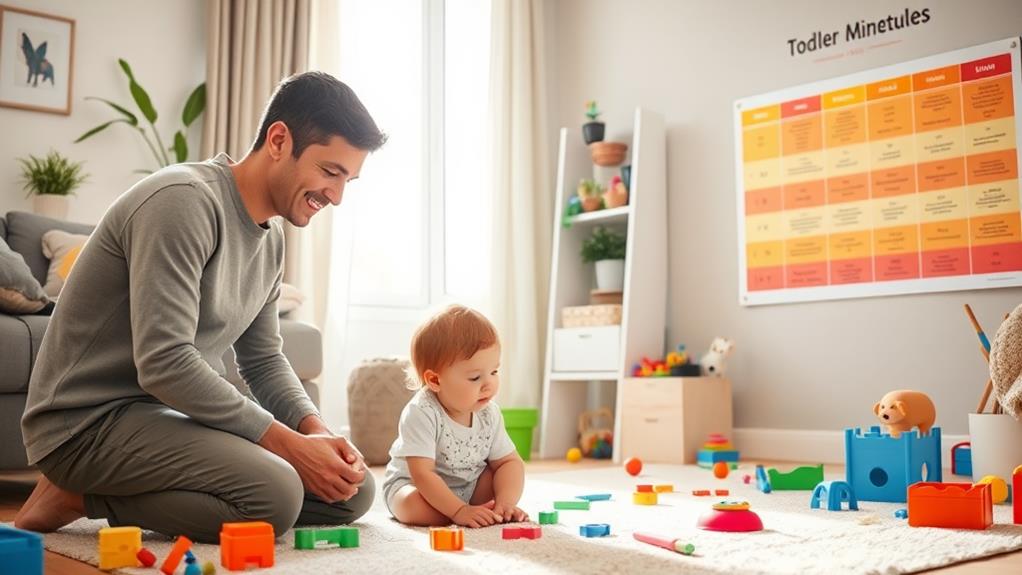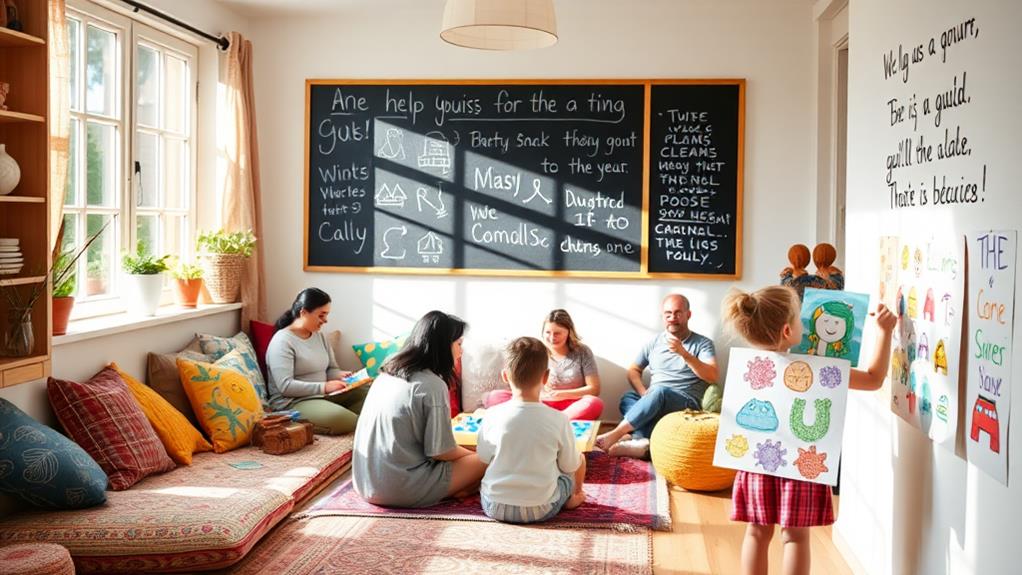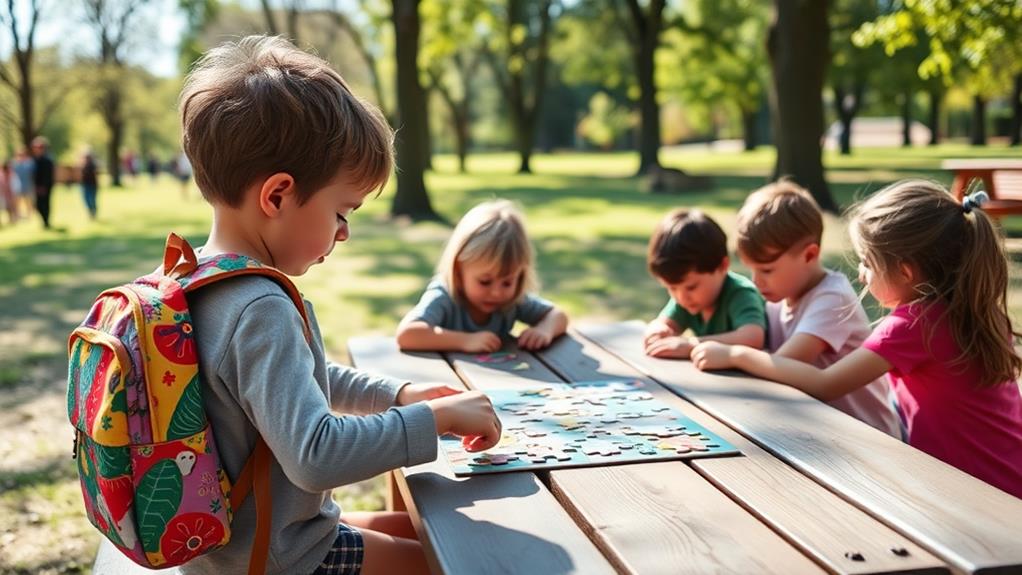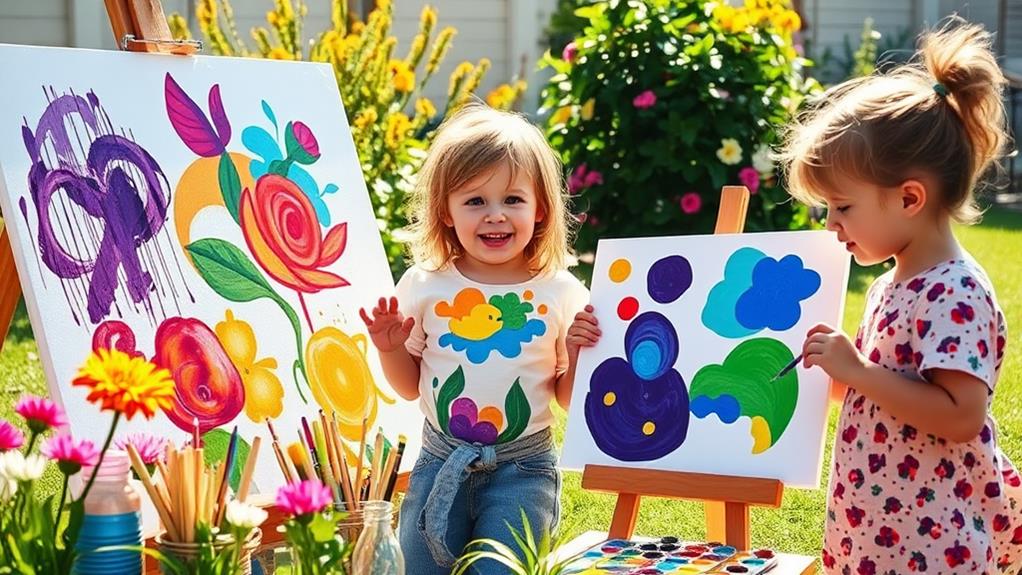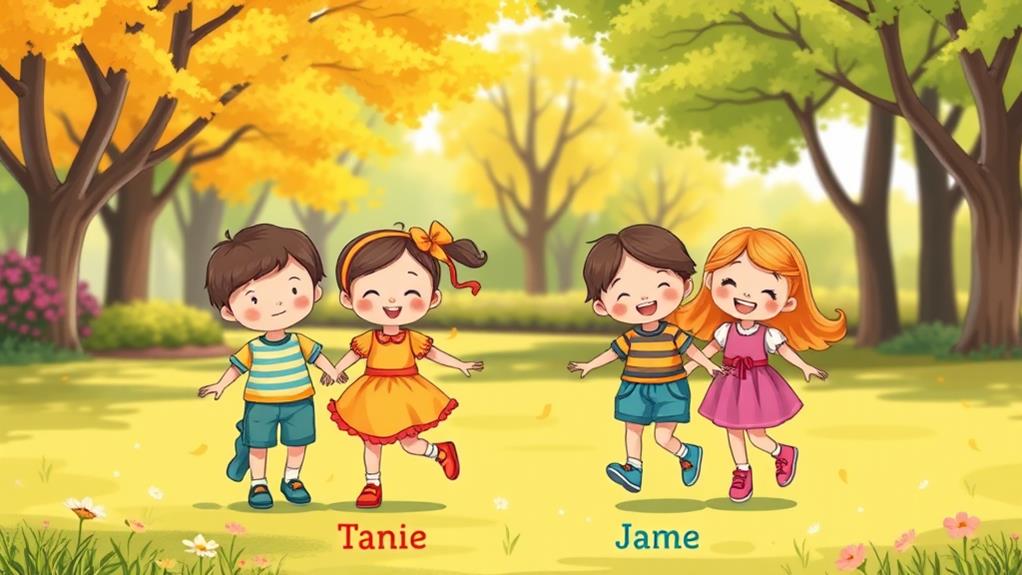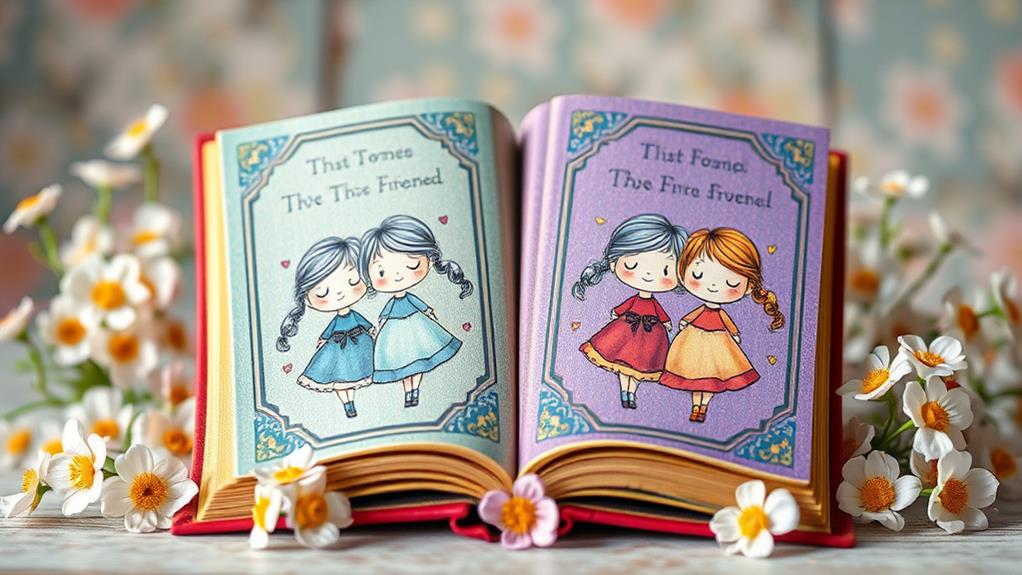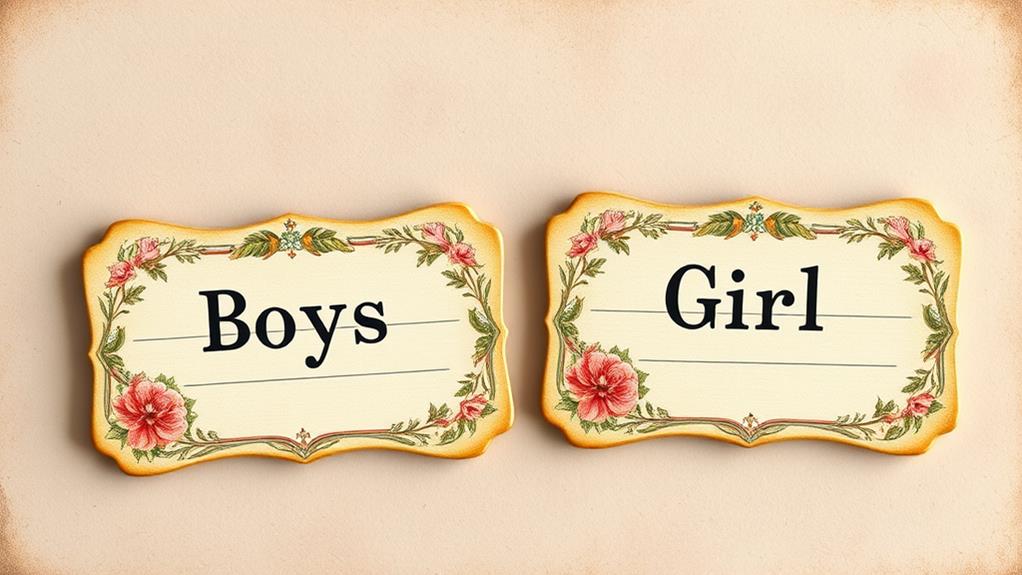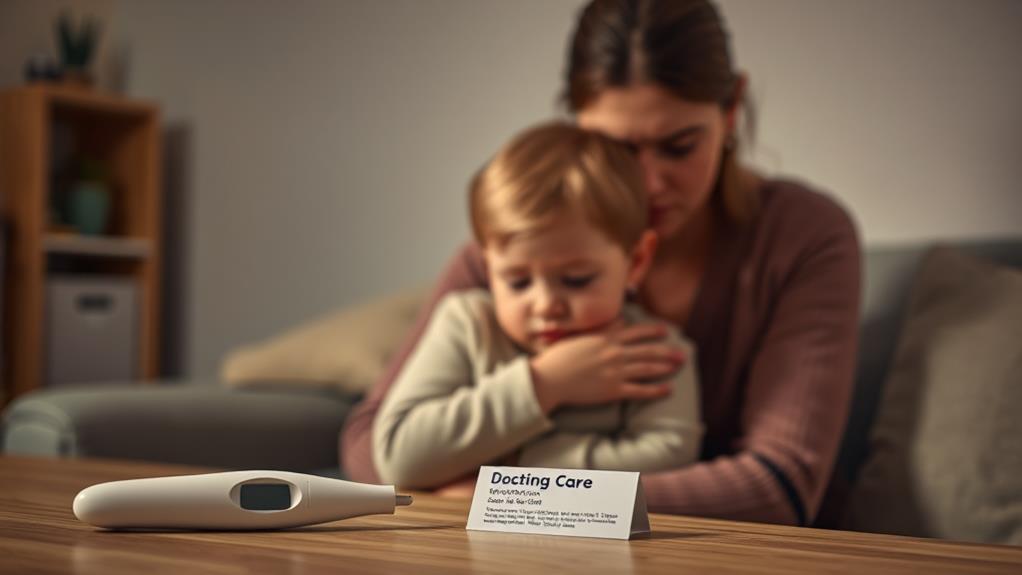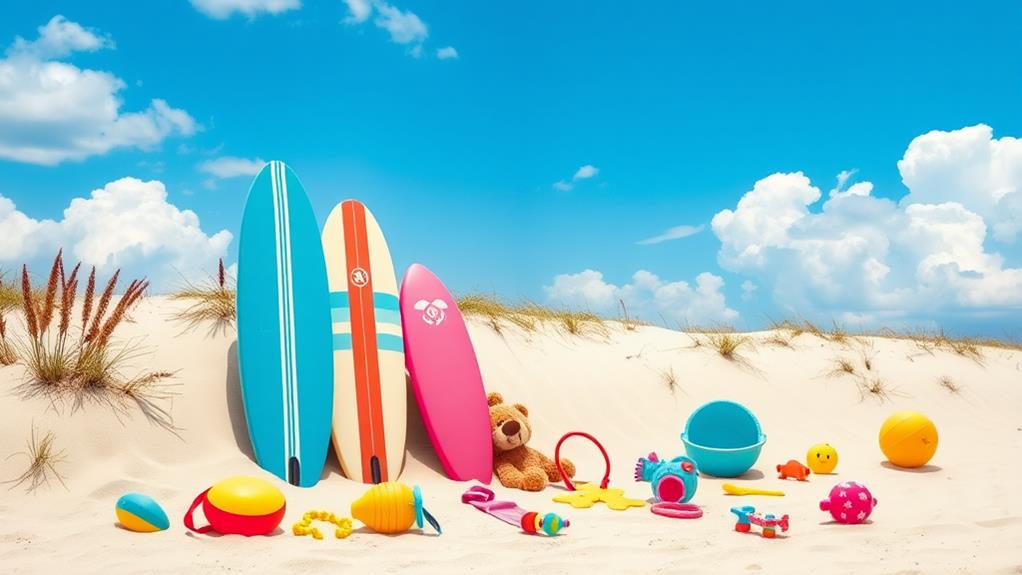If you're on the hunt for that ideal surfer-inspired baby name, you might want to explore a blend of oceanic charm and laid-back surf culture. Names like Kai and Bodhi not only embody the essence of the sea but also carry a sense of freedom. You'll find that some names honor legendary surfers, while others capture the playful spirit of beach life. But what makes these names truly special? The answer lies in their connections to the ocean and the lifestyle that surrounds it, which you'll discover as you explore the list further.
Ocean-Inspired Names
When you think of the ocean, names like Coral and Finn might immediately come to mind. These names are perfect for capturing the essence of the sea and its beauty. Coral, reminiscent of vibrant reefs and marine life, brings a sense of color and warmth. It's a name that embodies the spirit of the ocean's ecosystem.
On the other hand, Finn, relating to the fins of fish, evokes images of swimming and adventure beneath the waves.
Other ocean-inspired names include Marina, which means "from the sea," and is perfect for a girl who might grow up loving the beach. For boys, how about the name Cove? It suggests a hidden, tranquil spot along the shoreline, ideal for a child who enjoys exploring.
Additionally, names like Aqua and Oceana reflect the vastness of the water, emphasizing both beauty and depth.
Choosing an ocean-inspired name can give your child a connection to nature and the peacefulness of the sea. Whether it's a name linked to marine life or the water itself, these choices can evoke endless summers and beachy adventures, making them special and meaningful for your family.
Names From Surf Culture
Surf culture has a unique lexicon that often translates into vibrant names inspired by the sport and lifestyle. If you're looking for a name that captures the spirit of surfing, you might consider names like "Kai," which means "sea" in Hawaiian. This name not only sounds cool, but it also embodies the ocean's beauty.
Another option is "Bodhi," inspired by the famous surf film character and representing enlightenment, making it a meaningful choice.
For girls, "Sunny" brings to mind bright days spent at the beach, while "Wave" evokes images of rolling surf and carefree days. You might also like "Skye," reminiscent of the endless blue skies surfers enjoy.
If you're feeling adventurous, you could explore names like "Zuma," named after a popular surf spot in California, or "Maverick," which refers to the iconic big-wave surf location in Hawaii. Each of these names carries a sense of freedom and connection to the ocean.
Coastal City Names
Coastal cities offer a treasure trove of unique names that capture the essence of seaside living. When you think of beach vibes, names like Malibu, Kona, and Maui might come to mind. Each of these names brings a sense of adventure and relaxation, making them perfect for your little one.
Imagine calling your child "Carmel," inspired by the charming coastal town in California, known for its stunning ocean views and artistic community. Or consider "Savannah," which evokes thoughts of gentle breezes and beautiful coastlines in Georgia. Names like "Rio" and "Nassau" reflect vibrant cultures and warm sunshine, inviting images of fun-filled days at the beach.
If you want something more unique, how about "Dover"? This name brings to life the rich history of the coastal town in England. Alternatively, "Bali" transports you to a tropical paradise, perfect for a child destined for adventure.
Choosing a coastal city name not only connects your child to the beauty of the ocean but also instills a sense of wanderlust.
Names of Famous Surfers
The world of surfing is filled with legendary figures whose names evoke the thrill of riding the waves. If you're looking for inspiration, consider names like Kelly, after Kelly Slater, a surfer who's often regarded as the greatest of all time. His name represents skill and determination, making it a wonderful choice for your little one.
Another iconic name is Laird, inspired by Laird Hamilton, known for his big wave surfing and innovative style. Choosing Laird could give your child a sense of adventure and fearlessness.
Then there's Bethany, named after Bethany Hamilton, who overcame incredible challenges to continue surfing after losing her arm in a shark attack. Her story of resilience is truly inspiring.
For a more laid-back vibe, you might like the name Duke, honoring Duke Kahanamoku, the Hawaiian surfer who popularized the sport around the world.
These names not only celebrate surfing culture but also carry stories of bravery, passion, and achievement. So, whether you're a surfer yourself or simply appreciate the beachy lifestyle, consider one of these names to give your child a connection to the ocean's thrilling spirit.
Beachy Floral Names
If you're inspired by the beach lifestyle but want something softer than surfer names, beachy floral names might be just what you're looking for. These names capture the essence of coastal life while bringing a touch of nature into play. Think of names like Marigold or Jasmine, which evoke images of vibrant flowers swaying in the ocean breeze.
Choosing a floral name can reflect the beauty of the beach and the warmth of the sun. Names like Dahlia, Lily, or even Azalea offer a lovely, fresh vibe, perfect for your little one. You might also consider names like Meadow or Petal, which can conjure thoughts of sunny days spent among blossoming blooms.
These names not only sound beautiful, but they also carry a sense of peace and tranquility, reminiscent of lazy beach afternoons. Plus, floral names often have lovely meanings that can inspire your child throughout their life.
Wave-Inspired Names
Ocean waves have a rhythmic beauty that can inspire some truly unique baby names. If you're looking for a name that captures the essence of the sea, consider names like "Kai," which means "sea" in Hawaiian. It's short, sweet, and carries a sense of calmness.
Another beautiful choice is "Nalu," meaning "wave" in Hawaiian. This name not only reflects the ocean but also evokes a sense of adventure.
If you prefer something more traditional, "Mira" can be a lovely option. Derived from the Latin word for "ocean," it's elegant and timeless.
For a more playful twist, "Cove" stands out as a unique name that brings to mind serene bays and hidden beaches.
If you're drawn to the sound of waves, "Waverly" is a charming blend of both nature and sophistication.
Lastly, "Bora" is a name inspired by the Bora wind, which brings waves to the water's surface, connecting the elements of wind and sea beautifully.
These wave-inspired names can beautifully reflect your love for the ocean and its enchanting rhythms. Choose one that resonates with you and your family's beachy spirit!
Fun and Playful Names
Bright colors and laughter fill the air when you think of a beach day, and that spirit can be captured in fun and playful baby names. Choosing a name that reflects joy and playfulness adds a special touch to your little one's identity.
Think of names like Sunny, which instantly brings to mind bright skies and warmth. Or consider names like Coco, evoking images of coconut drinks and tropical vibes.
If you want something a bit more unique, how about naming your child after a cheerful fruit like Berry? It's sweet, fresh, and has a lighthearted ring to it.
Another option is Skipper, which brings to mind adventure and playful exploration.
You might also love names like Jett, which feels energetic and dynamic, perfect for a child destined for fun. For a more whimsical touch, names like Pixie or Doodle can really stand out.
These names not only carry a sense of playfulness but also spark imagination. So, as you embark on this exciting journey of naming your baby, think of names that capture that carefree beach vibe, ensuring your child starts life with a splash of joy!
Nautical-Themed Names
Nautical-themed names can evoke the spirit of the sea and all its adventures, making them a perfect choice for beach-loving parents. These names often carry a sense of freedom and exploration, reflecting the waves, winds, and marine life that inspire them.
For boys, consider names like "Finn," which not only represents the fin of a fish but also symbolizes a brave adventurer. "Nautilus" is another option, reminding us of the beautiful sea creature with its swirling shell.
For girls, "Marina" is a lovely choice, conjuring images of sparkling waters and serene harbors. "Coral" brings to mind vibrant reefs and the beauty of ocean ecosystems. You might also like "Sailor," a name that embodies the spirit of adventure on the open sea.
If you want something unique, "Beacon" can symbolize guidance and safety, like a lighthouse standing tall against the waves.
These names connect your little one to the ocean's wonder and charm. Embracing these nautical names can infuse your child's identity with the magic of the sea, setting the stage for a life filled with exploration and joy.
Names Inspired by Beaches
When you think of the beach, names that capture its essence can instantly transport you to sandy shores and sunlit days. Choosing a name inspired by the beach can evoke feelings of warmth, adventure, and relaxation.
Picture names like "Coral," which reflects the vibrant underwater life, or "Breezy," perfect for a child who'll bring a lightness to your life. You might also consider "Cove," suggesting a safe and peaceful retreat, or "Laguna," inspired by beautiful coastal lagoons.
These names carry a sense of tranquility, reminiscent of gentle waves lapping against the shore. Another great choice is "Marina," evoking images of boats bobbing in the water and families enjoying sunny afternoons.
If you prefer something more playful, "Sunny" can brighten anyone's day, while "Waves" captures the dynamic energy of the ocean.
These beach-inspired names not only sound lovely but also carry stories and memories of joyful times spent by the sea. So, as you search for that perfect name, let the beach guide you toward something truly special that'll remind you of those cherished moments.
Sandy Shore Names
On sun-drenched days at the beach, names inspired by sandy shores can bring to mind the warmth and comfort of a day spent playing in the sand. These names evoke images of golden grains, gentle breezes, and carefree moments under the sun.
Think of names like Sandy, which directly connects to the soft beach sand you love, or Shore, a simple yet elegant choice that captures the essence of coastal life.
Consider naming your little one after famous beaches, like Malibu or Waikiki. Both names carry a laid-back vibe, perfect for a child destined for adventure.
If you prefer something more unique, how about naming your baby after the stunning dunes? Dune is a fresh, trendy name that stands out while still feeling earthy.
You might also explore names like Cove, which brings to mind serene spots along the water, or Isla, meaning island, a nod to tropical escapes.
Whatever you choose, sandy shore names can inspire a sense of connection to nature and carefree days spent by the ocean.
Names From Marine Life
As you explore the beauty of beach-inspired names, consider the enchanting world of marine life. These names not only evoke the feel of the ocean but also carry a unique charm.
For instance, "Coral" brings to mind vibrant reefs and colorful underwater landscapes. It's a lovely name for a girl that reflects both strength and beauty.
If you're looking for something more adventurous, "Dolphin" is a playful option that symbolizes intelligence and friendliness. You could even consider "Finn," which pays homage to the fins of fish and sea creatures alike. It's a cool name that can suit any little water lover.
For a more exotic touch, "Marlin" draws inspiration from the swift and elegant fish known for its impressive size. This name has a strong yet gentle feel, making it a great choice for boys.
Tropical Island Names
Imagine wandering through a tropical paradise, where the names inspired by these idyllic islands evoke a sense of serenity and adventure. Tropical island names can bring the essence of sun-kissed shores and swaying palms right into your home. Names like Maui, for instance, not only sound beautiful but also carry the spirit of Hawaiian culture and the lush landscapes of the island.
Consider the name Bora, inspired by Bora Bora, a stunning gem in French Polynesia known for its clear lagoons and vibrant coral reefs. This name radiates a carefree vibe, perfect for a little one destined for fun adventures.
Another lovely option is Isla, which means "island" in Spanish and has a soft, soothing sound that can remind you of gentle waves lapping at the shore.
If you're looking for something unique, you might choose names like Fiji or Tonga, each with its rich history and warm, inviting feel. These names aren't just trendy; they connect your child to the beauty of nature and the spirit of exploration.
Names With a Breeze
Tropical island names can evoke a sense of calm and relaxation, just like the gentle breeze that sweeps across sandy shores. When you think about names inspired by the breeze, consider those that reflect the lightness and freedom associated with coastal living. Names like Zephyr, which means a gentle wind, can inspire feelings of serenity and adventure.
Another lovely option is Alize, derived from the trade winds that blow in the tropics. This name has a melodic quality, perfect for a child destined for a life full of exploration and joy. Similarly, you might find names like Mistral, inspired by the strong, cool winds of Southern France, evoke a sense of connection to nature.
If you prefer a more subtle reference, Breeze itself is a delightful choice. It captures that carefree spirit of beach days without being too on-the-nose.
Each of these names brings a unique energy, suggesting a life filled with laughter, sunshine, and warm days by the ocean. So, as you ponder the perfect name for your little one, think about what a gentle breeze represents—freedom, joy, and endless possibilities.
Sunrise and Sunset Names
Sunrises and sunsets paint the sky with breathtaking colors, and names inspired by these daily spectacles can evoke a sense of beauty and tranquility. Choosing a name that reflects the magic of dawn or dusk can give your child a unique connection to nature.
For girls, names like Aurora, meaning "dawn," and Sienna, inspired by the warm hues of sunset, are both lovely and meaningful. If you're looking for something more unusual, consider names like Zora, which means "dawn" in Slavic languages, or Solara, evoking the sun's energy.
For boys, you might like the name Asher, which means "blessed" and can remind you of those golden mornings. Another option is Cyrus, a name that brings to mind the sun itself. If you're feeling adventurous, you could choose names like Blaze, inspired by the fiery colors of a sunset, or even Phoenix, symbolizing rebirth and the vibrant colors of a disappearing sun.
These sunrise and sunset names can provide a beautiful, serene vibe, reflecting the natural beauty that surrounds us. Choose one that resonates with you, and let it inspire your little one's journey through life.
Names Celebrating Adventure
Adventure awaits those who seek it, and names that celebrate exploration can inspire a spirit of curiosity and boldness in your child. Consider names like "Atlas," which conjures images of grand adventures and brave journeys. This name not only refers to the Greek titan who held up the sky but also symbolizes strength and exploration.
Another great option is "Journey." This name reflects a love for travel and the excitement of new experiences. It's perfect for a child destined to explore the world.
"Sailor" is another adventurous choice that evokes the spirit of the sea and the thrill of sailing across vast oceans.
If you prefer something a bit more unique, "Quest" signifies a search for something valuable, encouraging your little one to pursue their dreams fearlessly.
Names like "Phoenix" can also inspire adventure, representing rebirth and resilience, ideal qualities for someone ready to tackle life's challenges.
Choosing a name that celebrates adventure not only gives your child a distinctive identity but also instills a sense of wonder and exploration.
After all, the world is vast, and there's so much to discover!
Short and Sweet Names
When it comes to naming your little one, short and sweet names pack a powerful punch. These names aren't only easy to say, but they also carry a charm that resonates with beach vibes and carefree days. Think of names like Kai, which means "sea" in Hawaiian, or Zia, which means "light" in Italian. These names invite an image of sun-soaked shores and playful ocean waves.
You'll find that short names are often memorable and can grow with your child. As they transition from babyhood to adulthood, a name like Finn or Mia can easily fit any stage of life. Plus, they're easy to shout across the beach when you need your little one's attention!
Another great aspect of short names is their versatility. You can pair them with longer middle names, creating a beautiful balance. For example, consider combining the name Lux with a longer middle name like Isabella for a unique twist.
Ultimately, short and sweet names embody the spirit of adventure and simplicity, allowing your beach-loving heart to shine through in your choice. Embrace these delightful options as you embark on this exciting journey of naming your baby!
Unique Spellings for Names
Creativity shines through unique spellings of names, adding a personal touch that sets your child's name apart. When you choose a name, think about how you can make it special with a twist. For instance, instead of the classic "Kaylee," you could spell it as "Kailie" or "Kailee." These variations not only look appealing but also give your child a distinctive identity.
You can also play with traditional names. "Catherine" can become "Katherin," while "Mikayla" can be spelled as "Micaela." Such unique spellings often catch people's attention and spark conversations. Plus, you'll find a sense of pride in knowing your child's name is one-of-a-kind.
Remember to keep pronunciation in mind, though! Unique spellings can lead to confusion if they're too far from the original name. Try to strike a balance between creativity and clarity. Combining different elements can also work well—like "Alyssa" transformed into "Alisah."
Ultimately, choosing a unique spelling is about celebrating individuality. It's a fun way to showcase your child's personality right from the start, making their name as special as they are!
Names Inspired by Surfboards
Surfboards often inspire names that exude a laid-back, beachy vibe. When you think about surf culture, you might picture vibrant colors and smooth lines, and those elements can translate beautifully into baby names.
For example, names like "Ryder" evoke a sense of adventure and motion, mirroring the feeling of riding waves. Similarly, "Blaine" can remind you of the sleek designs of surfboards, with its streamlined sound.
You might also consider names like "Finn," which reflects both the surfing lifestyle and the aquatic world. It's short, sweet, and has a fresh, fun feel. Another option is "Zane," bringing a cool, contemporary twist that fits perfectly with the surf scene.
For girls, names like "Coral" and "Sienna" channel the beautiful colors of the ocean and sandy shores, making them great choices for beach-loving families.
Each of these names carries an essence of adventure and freedom, ideal for a little one destined to embrace the ocean. When you choose a name inspired by surfboards, you're not just picking a label; you're selecting a piece of that carefree, sun-soaked lifestyle.
Names Reflecting Relaxation
Relaxation is at the heart of beach life, and names that evoke this sense of calm can be perfect for your little one. Choosing a name that reflects tranquility can set a soothing tone for their future. Consider names like "Breezy," which brings to mind gentle ocean winds, or "Soleil," the French word for sun, conjuring images of warm, sunny days by the shore.
You might also love "Cove," suggesting a peaceful inlet where waves gently lap at the sand. Names like "Mira," meaning ocean in Sanskrit, or "Luna," evoking the calming influence of the moon, can also inspire serenity.
Another option is "Kai," a Hawaiian name that signifies sea, connecting your child to the beauty of nature. These names not only sound lovely but also carry a deeper meaning, reflecting the easy-going lifestyle associated with beach living.
Choosing a name that embodies relaxation can be a thoughtful way to inspire calmness in your child's life. After all, there's something magical about the beach; it teaches us to embrace tranquility and enjoy life's simple pleasures.
Influential Surf Films Names
Many beach lovers find inspiration not just in the sand and surf but also in the films that celebrate this lifestyle. Movies like "Endless Summer" have captured hearts for decades. This classic surf documentary follows two surfers on a quest to find the perfect wave, and it's a name that carries a carefree vibe perfect for a baby.
You might also consider names from "Big Wednesday," a coming-of-age film that showcases friendship and the changing tides of life. The name "Wednesday" could evoke a sense of adventure and nostalgia.
Another great option is "Blue Crush," which tells the story of a young woman striving for her surfing dreams. The name "Blue" can symbolize the ocean's depths and beauty.
Lastly, "Gidget" is a fun, playful name from the 1959 film about a young girl who falls in love with surfing. It's a name that radiates joy and youthfulness.
These film-inspired names not only reflect the surf culture but also carry a sense of adventure and freedom. So, if you're looking for a beachy name with a story, these options are sure to inspire!
Gender-Neutral Beach Names
At the shore, names inspired by the ocean can be both beautiful and versatile. When choosing a name that reflects the beach vibe, consider gender-neutral options that resonate with the spirit of the sea. Names like "Ocean" and "Sky" evoke feelings of freedom and adventure, perfect for any little one.
You might also love names like "River" or "Harbor," which remind us of nature's calm and flowing beauty. These names aren't tied to any specific gender, making them modern choices that appeal to many parents today.
Another great option is "Sandy," which captures the essence of a sun-soaked beach day, while still being suitable for all genders.
For something a bit more unique, think about "Cove" or "Reef." These names reflect specific coastal features and bring a sense of tranquility. Plus, they're easy to spell and pronounce, making them practical choices for your child.
Ultimately, the best gender-neutral beach name for your baby will resonate with you, carrying the ocean's spirit into their life. So, dive into these options and see which one makes waves for your family!
Vintage Surf-Inspired Names
Surf culture from the past has a unique charm that can inspire some truly memorable baby names. Vintage surf-inspired names reflect a laid-back lifestyle and a love for the ocean, making them perfect for your little wave rider.
Think of names like "Bodhi," which means "enlightenment" and gained popularity from the classic surf film *Point Break*. It embodies a free spirit, perfect for a child destined to explore.
Another option is "Maverick," inspired by the famous surfing spot in California. It suggests independence and adventure, traits you might want for your child.
If you're looking for something softer, "Sunny" evokes images of bright beach days and warm sand, while also being unisex.
For girls, "Delilah" brings a vintage yet playful vibe, reminiscent of beach bonfires and summer nights. Names like "Wave" or "Skye" connect directly to nature, reflecting your ocean-loving family roots.
These vintage surf-inspired names can bring a sense of nostalgia and a connection to the exhilarating world of surfing. They're not just names; they're a celebration of a culture that embraces freedom, adventure, and the beauty of the coast.
Names for Ocean Lovers
If you're drawn to the ocean's beauty and tranquility, choosing a name that reflects that passion can be a meaningful decision. Names inspired by the ocean can evoke feelings of peace, adventure, and connection to nature.
You might consider names like "Marina," which means "from the sea," capturing the essence of ocean life. Another beautiful option is "Kai," a Hawaiian name meaning "ocean," perfect for a child destined to love the waves.
If you're looking for something unique, how about "Coral"? This name not only refers to the stunning underwater reefs but also carries a vibrant, lively feel.
For boys, "Caspian," inspired by the Caspian Sea, offers a strong, adventurous vibe. "Nerina," meaning "sea nymph," is a lovely choice for a girl, evoking enchanting stories of the ocean.
You might also consider "Dylan," which means "son of the sea" in Welsh, making it a timeless option.
These names can serve as a daily reminder of your love for the ocean, and they might inspire your child to embrace the water's wonders as they grow. Choose a name that reflects your passion, and let it carry the spirit of the sea.
Names Evoking Coastal Vibes
Embracing the coastal lifestyle can inspire a range of names that evoke the charm and beauty of beach life. Think about names like Coral and Pearl, which bring to mind shimmering seashells and vibrant reefs. These names not only sound lovely but also carry the essence of the ocean.
You might also consider names like Skye or Breeze, reflecting the open air and the gentle winds that dance along the shore.
If you're drawn to natural elements, names like Ocean or River can evoke feelings of serenity and adventure. For a more playful approach, you could choose names like Sandy or Shell, which capture the fun and carefree spirit of beach days.
Names inspired by warm colors can also evoke coastal vibes. For instance, names like Sunny or Marigold remind you of golden sunsets and sun-kissed skin.
When choosing a name, think about what feelings you want to evoke. Whether you want a name that brings to mind the sound of waves or the warmth of the sun, the right coastal-inspired name can create a connection to the beach that lasts a lifetime.
Names From Surfing Terminology
The thrill of catching a wave can inspire unique names drawn from surfing terminology. If you're a beach lover or a surfer at heart, consider these names for your little one.
"Bodhi" comes from the bodysurfing board, evoking a laid-back vibe and a sense of adventure. "Reef" symbolizes the beauty of marine life and the ecosystems that surfers cherish.
Another fun option is "Koa," which means warrior in Hawaiian, representing strength and courage. For a girl, "Sandy" captures the essence of sun-soaked beaches and playful days by the shore.
"Cruz" is another great choice, inspired by the word "cruise," which embodies the joy of riding waves and exploring the ocean. "Wave" itself can be a bold name, connecting your child to the rhythm of the sea.
Lastly, "Zuma," after the famous surf spot in California, carries a cool, trendy vibe.










